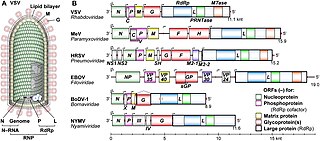
Rhabdoviridae is a family of negative-strand RNA viruses in the order Mononegavirales. Vertebrates, invertebrates, plants, fungi and protozoans serve as natural hosts. Diseases associated with member viruses include rabies encephalitis caused by the rabies virus, and flu-like symptoms in humans caused by vesiculoviruses. The name is derived from Ancient Greek rhabdos, meaning rod, referring to the shape of the viral particles. The family has 40 genera, most assigned to three subfamilies.

Mononegavirales is an order of negative-strand RNA viruses which have nonsegmented genomes. Some members that cause human disease in this order include Ebola virus, human respiratory syncytial virus, measles virus, mumps virus, Nipah virus, and rabies virus. Important pathogens of nonhuman animals and plants are also in the group. The order includes eleven virus families: Artoviridae, Bornaviridae, Filoviridae, Lispiviridae, Mymonaviridae, Nyamiviridae, Paramyxoviridae, Pneumoviridae, Rhabdoviridae, Sunviridae, and Xinmoviridae.
Tick-borne diseases, which afflict humans and other animals, are caused by infectious agents transmitted by tick bites. They are caused by infection with a variety of pathogens, including rickettsia and other types of bacteria, viruses, and protozoa. The economic impact of tick-borne diseases is considered to be substantial in humans, and tick-borne diseases are estimated to affect ~80 % of cattle worldwide. Most of these pathogens require passage through vertebrate hosts as part of their life cycle. Tick-borne infections in humans, farm animals, and companion animals are primarily associated with wildlife animal reservoirs. Many tick-borne infections in humans involve a complex cycle between wildlife animal reservoirs and tick vectors. The survival and transmission of these tick-borne viruses are closely linked to their interactions with tick vectors and host cells. These viruses are classified into different families, including Asfarviridae, Reoviridae, Rhabdoviridae, Orthomyxoviridae, Bunyaviridae, and Flaviviridae.

Bunyavirales is an order of segmented negative-strand RNA viruses with mainly tripartite genomes. Member viruses infect arthropods, plants, protozoans, and vertebrates. It is the only order in the class Ellioviricetes. The name Bunyavirales derives from Bunyamwera, where the original type species Bunyamwera orthobunyavirus was first discovered. Ellioviricetes is named in honor of late virologist Richard M. Elliott for his early work on bunyaviruses.

Viral hemorrhagic fevers (VHFs) are a diverse group of animal and human illnesses. VHFs may be caused by five distinct families of RNA viruses: the families Filoviridae, Flaviviridae, Rhabdoviridae, and several member families of the Bunyavirales order such as Arenaviridae, and Hantaviridae. All types of VHF are characterized by fever and bleeding disorders and all can progress to high fever, shock and death in many cases. Some of the VHF agents cause relatively mild illnesses, such as the Scandinavian nephropathia epidemica, while others, such as Ebola virus, can cause severe, life-threatening disease.
Bwamba orthobunyavirus (BWAV) belongs to the genus Orthobunyavirus and the order Bunyavirales RNA viruses. BWAV is present in large parts of Africa, endemic in Mozambique, Tanzania and Uganda. It is transmitted to humans through mosquito bites and results in a brief benign generalised infection with headache, skin rash, diarrhea and joint pain and lasts 4–5 days. The animal reservoir of the virus includes birds, monkeys and donkeys.
Mokola lyssavirus, commonly called Mokola virus (MOKV), is an RNA virus related to rabies virus that has been sporadically isolated from mammals across sub-Saharan Africa. The majority of isolates have come from domestic cats exhibiting symptoms characteristically associated to rabies virus infection.

Crimean–Congo hemorrhagic fever (CCHF) is a viral disease. Symptoms of CCHF may include fever, muscle pains, headache, vomiting, diarrhea, and bleeding into the skin. Onset of symptoms is less than two weeks following exposure. Complications may include liver failure. Survivors generally recover around two weeks after onset.

Oropouche fever is a tropical viral infection which can infect humans. It is transmitted by biting midges and mosquitoes, from a natural reservoir which includes sloths, non-human primates, and birds. The disease is named after the region where it was first discovered and isolated in 1955, by the Oropouche River in Trinidad and Tobago. Oropouche fever is caused by the Oropouche virus (OROV), of the Bunyavirales order of viruses.

Orbivirus is a genus of double-stranded RNA viruses in the family Reoviridae and subfamily Sedoreovirinae. Unlike other reoviruses, orbiviruses are arboviruses. They can infect and replicate within a wide range of arthropod and vertebrate hosts. Orbiviruses are named after their characteristic doughnut-shaped capsomers.
African horse sickness (AHS) is a highly infectious and often fatal disease caused by African horse sickness virus. It commonly affects horses, mules, and donkeys. It is caused by a virus of the genus Orbivirus belonging to the family Reoviridae. This disease can be caused by any of the nine serotypes of this virus. AHS is not directly contagious, but is known to be spread by insect vectors.

Chapare mammarenavirus or Chapare virus is a virus from the family Arenaviridae which causes a hemorrhagic fever in humans known as Chapare hemorrhagic fever. It was first described after an outbreak of a novel zoonotic mammarenavirus infection occurred in the village of Samuzabeti, Chapare Province, Bolivia, in January 2003. A small number of people were infected and one person died.
Lujo is a bisegmented RNA virus—a member of the family Arenaviridae—and a known cause of viral hemorrhagic fever (VHF) in humans. Its name was suggested by the Special Pathogens Unit of the National Institute for Communicable Diseases of the National Health Laboratory Service (NICD-NHLS) by using the first two letters of the names of the cities involved in the 2008 outbreak of the disease, Lusaka (Zambia) and Johannesburg. It is the second pathogenic Arenavirus to be described from the African continent—the first being Lassa virus—and since 2012 has been classed as a "Select Agent" under U.S. law.

Theileria parva is a species of parasites, named in honour of Arnold Theiler, that causes East Coast fever (theileriosis) in cattle, a costly disease in Africa. The main vector for T. parva is the tick Rhipicephalus appendiculatus. Theiler found that East Coast fever was not the same as redwater, but caused by a different protozoan.

Zaire ebolavirus, more commonly known as Ebola virus, is one of six known species within the genus Ebolavirus. Four of the six known ebolaviruses, including EBOV, cause a severe and often fatal hemorrhagic fever in humans and other mammals, known as Ebola virus disease (EVD). Ebola virus has caused the majority of human deaths from EVD, and was the cause of the 2013–2016 epidemic in western Africa, which resulted in at least 28,646 suspected cases and 11,323 confirmed deaths.
Batai orthobunyavirus (BATV) is a RNA virus belonging to order Bunyavirales, genus Orthobunyavirus.
Epizootic hemorrhagic disease virus, often abbreviated to EHDV, is a species of the genus Orbivirus, a member of the family Reoviridae. It is the causative agent of epizootic hemorrhagic disease, an acute, infectious, and often fatal disease of wild ruminants. In North America, the most severely affected ruminant is the white-tailed deer, although it may also infect mule deer, black-tailed deer, elk, bighorn sheep, and pronghorn antelope. It is often mistakenly referred to as “bluetongue virus” (BTV), another Orbivirus that like EHDV causes the host to develop a characteristic blue tongue due to systemic hemorrhaging and lack of oxygen in the blood. Despite showing clinical similarities, these two viruses are genetically distinct.

Bourbon virus is an RNA virus in the genus Thogotovirus of the family Orthomyxoviridae, which is similar to Dhori virus and Batken virus. It was first identified in 2014 in a man from Bourbon County, Kansas, United States, who died after being bitten by ticks. The case is the eighth report of human disease associated with a thogotovirus globally, and the first in the Western hemisphere. As of May 2015, a case was discovered in Stillwater, Oklahoma, and relatively little is known about the virus. No specific treatment or vaccine is available. The virus is suspected to be transmitted by ticks or insects, and avoidance of bites is recommended to reduce risk of infection. In June 2017 a 58-year-old female Missouri State Park employee died from an infection of the Bourbon virus after it had been misdiagnosed for a significant period of time.

Tibrovirus is a poorly characterized genus of viruses in the family Rhabdoviridae, order Mononegavirales. There are 8 members of the genus. Tibroviruses have been isolated from biting midges, cattle, and humans. None of the tibroviruses, except for Bas-Congo virus, have been associated with any diseases.
Ekpoma viruses, including Ekpoma 1 tibrovirus (EKV-1) and Ekpoma 2 tibrovirus (EKV-2), are orphan viruses not associated with any disease. They are negative-sense RNA viruses and members of the rhabdovirus family. Both viruses were discovered in 2015 in blood samples collected from two healthy women living in Ekpoma, Nigeria. EKV-2 appears to be widespread and ~45% of people living in and around Ekpoma have been previously exposed. Both viruses have very broad cellular tropism and the ability to infect a wide range of human cancer cell lines. Neither virus has been isolated, hindering research.











